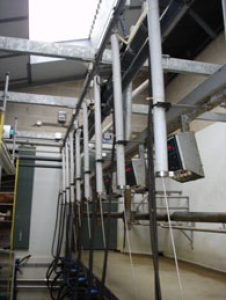Milking and Milking Parlour
Managing dairy herds automatically

However, the benefits of being able to remotely track and trace individual animals and follow their development are now becoming essential as part of the management of a business.
Tracking and tracing, RFID, HACCP, quality assurance schemes and automation are increasingly moving onto the farm and into the factory to provide farmers, managers, vets and breeders with more and more information to help them run their business more efficiently and profitably. The need to manage the information about individual animals is becoming more important as the number of animals on a farm grows, farms get bigger and fewer and labour and feed costs rise.
 |
| The milking parlour on the Hunnerlink's farm using Nedap automatic technology. |
The better the information is managed, the easier it is to reduce waste and costs and increase productivity and efficiency. In the dairy farming industry, automated milking systems, linked to automated feed programmes, can not only make herd management easier, but also improve the herd health, milk output and general animal welfare.
On Gerrit and Inge Hunnerlink's farm in Zutphen in the east of the Netherlands the automated management system, from the Dutch electronics and management systems company Nedap, monitors the milk production, controls feed and supplements, checks for mastitis and shows then the cow is ready to be artificially inseminated.
The Nedap system is controlled by a transponder that is strapped around the cow's neck by a collar.
In the barn the cows are given a general mix of feed and concentrate, but there is also an automatic feeding station that allows the cow to receive individually tailored amounts of feed supplement. The feed regime is drawn up for each cow according to needs and when the cow goes to the feeding station the transponder send the information on how much feed supplement is taken and by which animal. The information is fed back to a computer and logged. The system sends out an alarm if the cow is not receiving enough supplement, which could be a warning sign that there is something wrong with the animal. The cows are given between one and 12kg of feed concentrate a day divided into four or five portions to allow time for the supplements to be digested. Each feeding station will monitor 25 animals.
The main checks on the animals are carried out during milking in an automatic milking parlour.
The cow's individual number is read through an antenna as she comes into the milking parlour and the milking place the cow goes to is also logged. At the milking station, the Nedap system monitors the speed of the milking and the amount of milk. It will also show the fat and protein content and compares the figures with previous records. The system will send out an alarm if something unusual is recorded, this allows the farmer or stockman to check the animal.
On Mr and Mrs Hunnerlink's farm, the automated parlour can milk 100 cows an hour and the daily milk production is 28kg, with an average annual production of 8,200 kg for the herd.
The system also checks the conductivity of the milk to monitor the possibility of mastitis - the higher the conductivity the more likelihood of mastitis.
The system at Mr Hunnerlink's farm also has the Nedap heat detector that allows the farmer to check when cows come on heat and shows the best time for them to be put to insemination.
The system monitors the vital signs and activity of the animal logging its movements day and night through the transponder and battery operated activity counters. A change in activity compared to the norm for the animal, shows that she is coming on heat.
"The only other way to check whether an animal is coming on heat is to do it visually and check the herd twice a day or more," said Rutger Woolderink from Nedap Agri.
"This takes a lot of time. But the heat detector shows changes of activity in the data and sends an alarm when an animal is on heat."
The heat detector increases the productivity of the animal by reducing calving intervals and requiring fewer inseminations.
The system gives both and individual analysis of each animal's performance and an overall herd analysis.
If an alarm rings, for any number of reasons, the animal can be automatically separated from the rest of the herd as she leaves the milking parlour, as the system reads the transponder as the animal passes an antenna.
The whole walking area for the cows in the barn is also cleaned regularly and automatically, using a Lely Discovery robotic cleaner that washes down the areas of manure.
The Nedap system is an internet based system that allows the farmer or stockman to view the data remotely anywhere within range of the server installed on the farm. The system also allows other essential people, such as vets, to monitor the situation if there has been a problem on the farm.
According to Nedap, the entire automatic dairy management system helps to reduce labour costs and increase the efficiency and productivity of the dairy unit.













